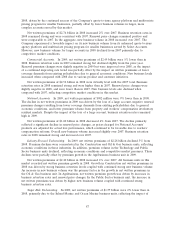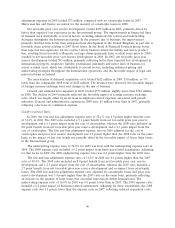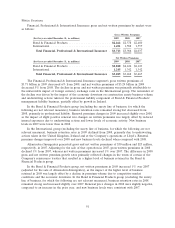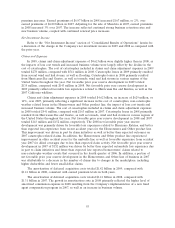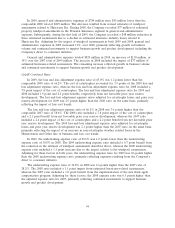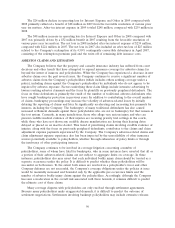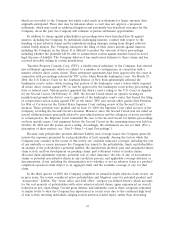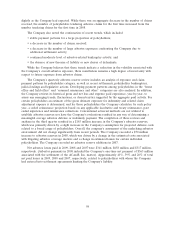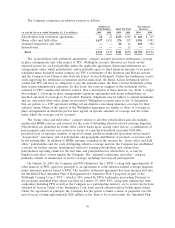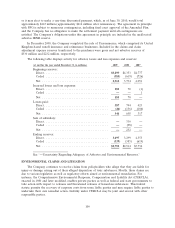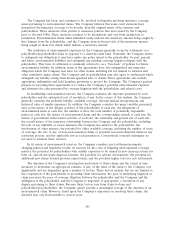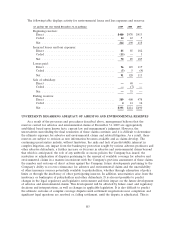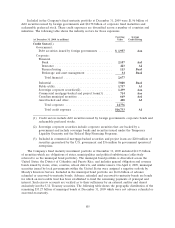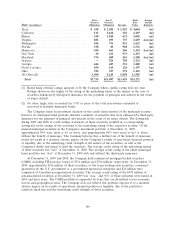Travelers 2009 Annual Report Download - page 108
Download and view the complete annual report
Please find page 108 of the 2009 Travelers annual report below. You can navigate through the pages in the report by either clicking on the pages listed below, or by using the keyword search tool below to find specific information within the annual report.The $24 million decline in operating loss for Interest Expense and Other in 2009 compared with
2008 primarily reflected a benefit of $28 million in 2009 from the favorable resolution of various prior
year tax matters. After-tax interest expense in 2009 totaled $248 million, compared with $239 million in
2008.
The $48 million increase in operating loss for Interest Expense and Other in 2008 compared with
2007 was primarily driven by a $52 million benefit in 2007 resulting from the favorable resolution of
various prior year tax matters. The net loss in 2008 included after-tax interest expense of $239 million,
compared with $224 million in 2007. The net loss in 2007 also included an after-tax loss of $25 million
related to the Company’s redemption of its 4.50% contingently convertible debentures in April 2007,
consisting of the redemption premium paid and the write-off of remaining debt issuance costs.
ASBESTOS CLAIMS AND LITIGATION
The Company believes that the property and casualty insurance industry has suffered from court
decisions and other trends that have attempted to expand insurance coverage for asbestos claims far
beyond the intent of insurers and policyholders. While the Company has experienced a decrease in new
asbestos claims over the past several years, the Company continues to receive a significant number of
asbestos claims from the Company’s policyholders (which includes others seeking coverage under a
policy), including claims against the Company’s policyholders by individuals who do not appear to be
impaired by asbestos exposure. Factors underlying these claim filings include intensive advertising by
lawyers seeking asbestos claimants and the focus by plaintiffs on previously peripheral defendants. The
focus on these defendants is primarily the result of the number of traditional asbestos defendants who
have sought bankruptcy protection in previous years. In addition to contributing to the overall number
of claims, bankruptcy proceedings may increase the volatility of asbestos-related losses by initially
delaying the reporting of claims and later by significantly accelerating and increasing loss payments by
insurers, including the Company. The bankruptcy of many traditional defendants has also caused
increased settlement demands against those policyholders who are not in bankruptcy but that remain in
the tort system. Currently, in many jurisdictions, those who allege very serious injury and who can
present credible medical evidence of their injuries are receiving priority trial settings in the courts,
while those who have not shown any credible disease manifestation are having their hearing dates
delayed or placed on an inactive docket. This trend of prioritizing claims involving credible evidence of
injuries, along with the focus on previously peripheral defendants, contributes to the claims and claim
adjustment expense payments experienced by the Company. The Company’s asbestos-related claims and
claim adjustment expense experience also has been impacted by the unavailability of other insurance
sources potentially available to policyholders, whether through exhaustion of policy limits or through
the insolvency of other participating insurers.
The Company continues to be involved in coverage litigation concerning a number of
policyholders, some of whom have filed for bankruptcy, who in some instances have asserted that all or
a portion of their asbestos-related claims are not subject to aggregate limits on coverage. In these
instances, policyholders also may assert that each individual bodily injury claim should be treated as a
separate occurrence under the policy. It is difficult to predict whether these policyholders will be
successful on both issues. To the extent both issues are resolved in a policyholder’s favor and other
Company defenses are not successful, the Company’s coverage obligations under the policies at issue
would be materially increased and bounded only by the applicable per-occurrence limits and the
number of asbestos bodily injury claims against the policyholders. Accordingly, although the Company
has seen a moderation in the overall risk associated with these lawsuits, it remains difficult to predict
the ultimate cost of these claims.
Many coverage disputes with policyholders are only resolved through settlement agreements.
Because many policyholders make exaggerated demands, it is difficult to predict the outcome of
settlement negotiations. Settlements involving bankrupt policyholders may include extensive releases
96



